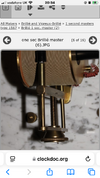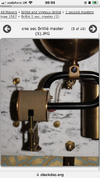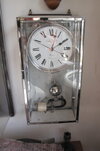Permanent magnet clock
- Thread starter wombweller
- Start date
To magnetise an iron bar you simply wrap a suitable number of turns of wire round it, then apply current to it - a hard iron bar will become a permanent magnet, and a soft iron bar will become an electro-magnet (only a magnet when power is applied).
It's simple high school (or primary school) physics.
Going back to those long ago days, a nail (the classic example) is 'hard iron', so becomes a permanent magnet - to make it 'soft' you heat it up, and let it cool down slowly. Generally in those types of experiment you were looking to make an electro-magnet.
It's simple high school (or primary school) physics.
Going back to those long ago days, a nail (the classic example) is 'hard iron', so becomes a permanent magnet - to make it 'soft' you heat it up, and let it cool down slowly. Generally in those types of experiment you were looking to make an electro-magnet.
wombweller
Member
Hi Nigel thank you for your reply.
So in a nutshell I need an hard iron bar in the diameter I require, wrap a coil around it in however many turns and put low volts through it!
Does the volts and amps need to be anything specific?
You say hard iron for a permanent magnet, there might be some Annealing required to bend the bar to shape, will this effect what’s required ie a permanent magnet?
Many thanks
So in a nutshell I need an hard iron bar in the diameter I require, wrap a coil around it in however many turns and put low volts through it!
Does the volts and amps need to be anything specific?
You say hard iron for a permanent magnet, there might be some Annealing required to bend the bar to shape, will this effect what’s required ie a permanent magnet?
Many thanks
The fine tune is to raise or lower the weight swinging on the pendulum to adjust the duration of the swing. These clocks are quite special and were among the first to use the alloy "Invar" - an alloy containing a lot of nickel. This alloy undergoes a phase change to a lattice that is slightly more dense near room temperature. As the material expands from being heated, it simultaneously contracts as the phase changes to yield a near-zero thermal expansion. That way, the rod that holds the weight is always the same length and the clock is much more accurate for rooms with varying temperatures throughout the day or year - a feature that was much more important pre-air conditioning. This alloy (and slight variations) is commonly used in optical systems like telescopes and Lidar modules..
Once you've got it to the required shape, then 'harden' the iron again - heat it up and drop it in cold water.
As for how many turns?, I don't think it's critical - as kids we just wound as many turns of the wire we'd found somewhere, and stuck it across a battery.
As for how many turns?, I don't think it's critical - as kids we just wound as many turns of the wire we'd found somewhere, and stuck it across a battery.
wombweller
Member
Nigel do you think it makes any difference if I magnetise it while it’s in the shape I require?
Many thanks
Many thanks
wombweller
Member
Hi. These clocks are fabulous and I’m making a 1 second beat version, the more common version is the half seconds. I used to own a 1 seconds but sold it and then regretted it, ha well you live and learne.The fine tune is to raise or lower the weight swinging on the pendulum to adjust the duration of the swing. These clocks are quite special and were among the first to use the alloy "Invar" - an alloy containing a lot of nickel. This alloy undergoes a phase change to a lattice that is slightly more dense near room temperature. As the material expands from being heated, it simultaneously contracts as the phase changes to yield a near-zero thermal expansion. That way, the rod that holds the weight is always the same length and the clock is much more accurate for rooms with varying temperatures throughout the day or year - a feature that was much more important pre-air conditioning. This alloy (and slight variations) is commonly used in optical systems like telescopes and Lidar modules..
The fine tune is on the coil there is adjustment on the pendulum by way of moving the whole bob around.
The fine tune on the coil moves iron rods either side of the coil up or down and these iron rods interfere with the magnetism some how, I’m looking for more details on this so I understand it.
Many thanks
Nigel do you think it makes any difference if I magnetise it while it’s in the shape I require?
Many thanks
Yes, you SHOULD magnetise it when it's in the required shape.
wombweller
Member
Cool thank you for this.Yes, you SHOULD magnetise it when it's in the required shape.
Big Clive describes a number of similar things on YouTube.
Two relative videos are here but there are several others.


Two relative videos are here but there are several others.


wombweller
Member
Thank you, nice video but not really what I am looking for.Big Clive describes a number of similar things on YouTube.
Two relative videos are here but there are several others.
wombweller
Member
Cool thank you for this.
Can you explain the two iron rods either side of the coil. It is known that when these are adjusted up or down they rate the pendulum but only very slightly so fine rating, I have no idea of what is happening magically?Cool thank you for this.
wombweller
Member
Can you explain the two iron rods either side of the coil. It is known that when these are adjusted up or down they rate the pendulum but only very slightly so fine rating, I have no idea of what is happening magically?Yes, you SHOULD magnetise it when it's in the required shape.
Can you explain the two iron rods either side of the coil. It is known that when these are adjusted up or down they rate the pendulum but only very slightly so fine rating, I have no idea of what is happening magically?
Sorry, I know nothing about the clock, just distant memories of making magnets and electro-magnets in my childhood
Similar threads
- Replies
- 12
- Views
- 1K
- Replies
- 91
- Views
- 15K
- Replies
- 18
- Views
- 5K
- Replies
- 14
- Views
- 8K



